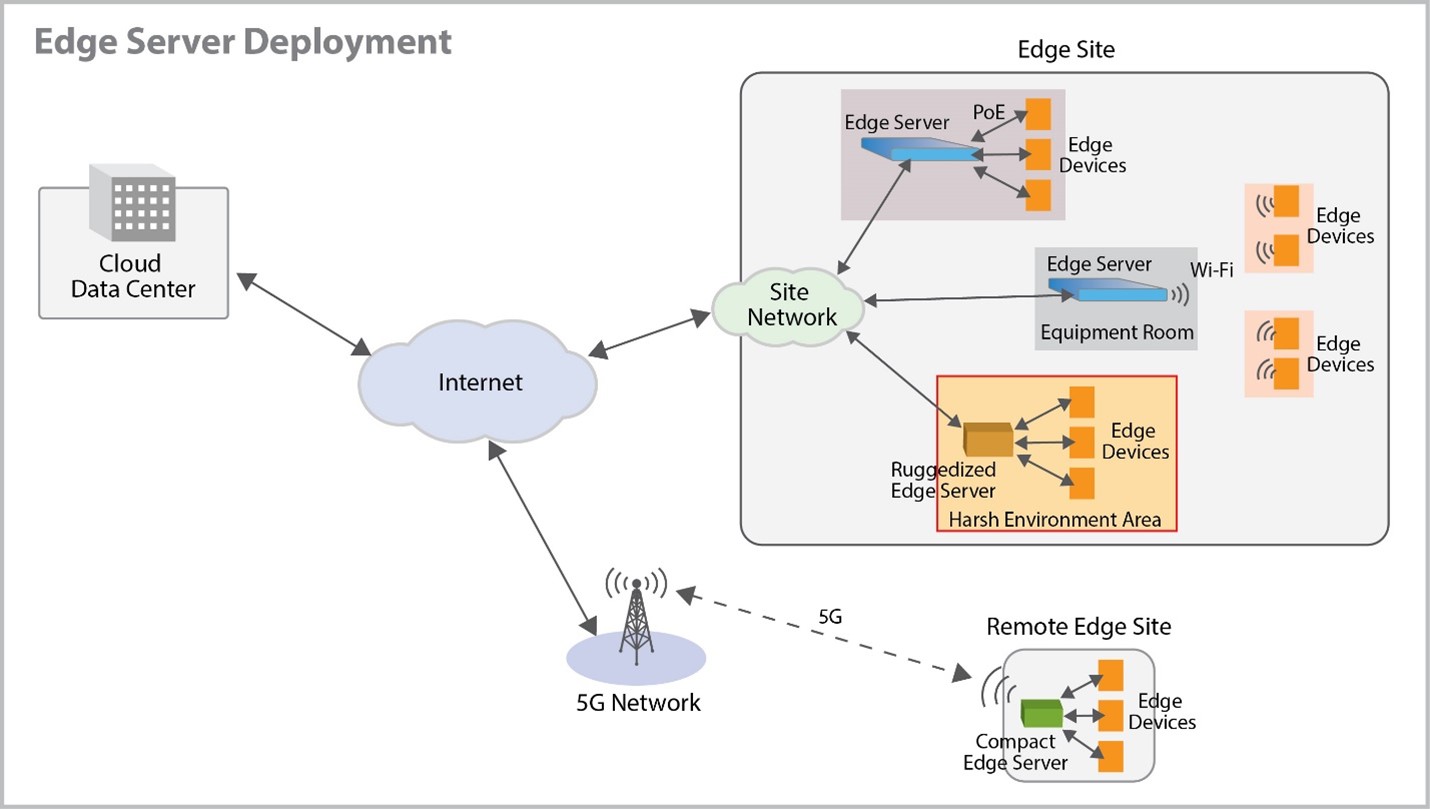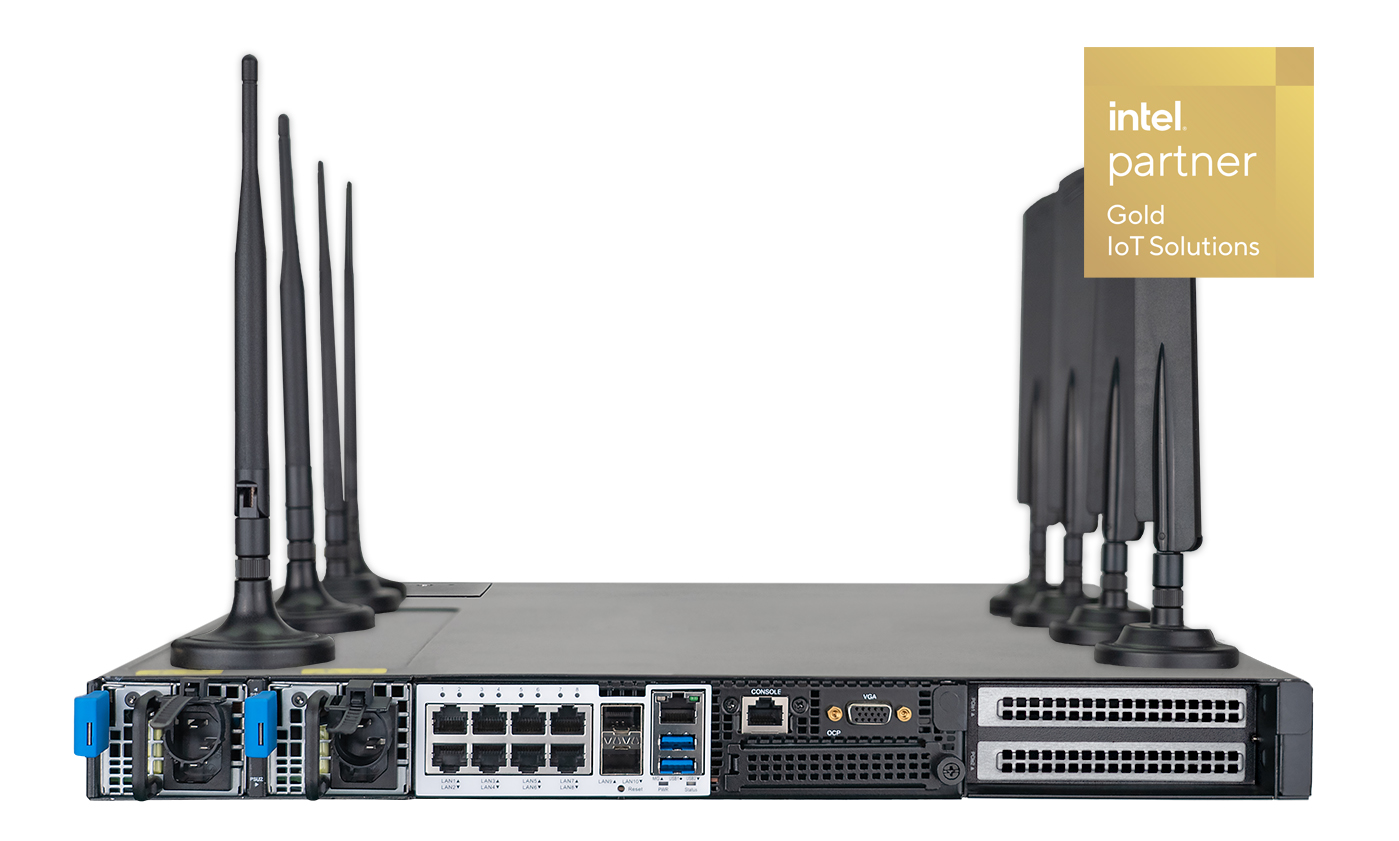Edge Server Applications Expanding
What are Edge Computing Devices?
A huge amount of data is generated every day, and an increasing percentage of that data is collected from small devices at the edge of networks. IoT (Internet of Things) devices, industrial sensors, security systems, and increasingly Artificial Intelligence (AI) applications, all contribute to the mountain of data that requires processing and analysis. As the problems of moving a high-volume of data to centralized cloud data centers become apparent, more compute resources have needed to be placed closer to data sources. The computing requirements at the network edge, or “edge computing” devices, come in a number of forms depending on the application and environment. However, all edge computing devices remove a large portion of the latency problems and other possible network congestion or disruptions that can prevent systems functioning efficiently.
Some small edge devices can include enough of their own compute resources for the basic processing of their data, but typically data is collected by a computer at the edge, called an “edge server,” which processes raw data before sending results or analysis to a cloud data center. Edge servers are often located at a specific site close to the data, which may involve size or power limitations. Alternatively, edge servers may be deployed in on-site data centers or in nearby locations where higher performance compute and storage can be implemented. The features and resources that define edge server hardware can vary widely, but these platforms typically fall into three main categories; compact and/or low power for restricted environments, ruggedized for harsh environments, and standard rack-based units. Whatever their form, the use of edge servers is rapidly increasing and these flexible platforms are continuing to evolve and find new applications at the network edge.

What Features Define an Edge Server?
If an edge server needs to be deployed in a harsh industrial environment to be close to a data source, then the hardware needs to be “ruggedized.” That is, the device needs to withstand temperature extremes, high levels of dirt and dust, and possibly constant vibrations or shocks. In addition, a rugged edge server may be limited by size, yet still have to provide the compute performance and storage required for its application. By selecting temperature-hardened components and using sealed enclosures with specialized cooling, it is possible to design rugged edge server systems that are without fans and vents typical on most servers. These ruggedized edge servers can deliver reliable performance in many extreme industrial locations where ordinary server systems would fail.
For edge servers that are deployed at an edge site, but are housed in a controlled environment, such as a cabinet or equipment room, these can be standard rack-mounted devices that do not require any rugged design features. Rack-mounted edge servers are not restricted by size or power requirements and therefore tend to be designed with more compute and storage resources to handle heavier workloads. These systems can also include additional features for deployment flexibility and offer expansion options for accommodating specialized tasks.
The following table summarizes some of the key features that can be found in most edge server designs. Note that a specific edge server would not include all of these features, just only a subset based on a system’s deployment demands.
| Edge Server Feature | Specification Options | Note |
|---|---|---|
| Ruggedized | Extreme temperature range, sealed enclosure, fanless | For edge servers deployed in harsh environments |
| Compact | Small enough to fit space-constrained locations | Size restrictions can apply in some edge environments |
| CPU | Multi-core, low power, or SoC (system on chip) | Performance needs to handle the processing workloads |
| Storage | SSD, NVMe SSD | Integrated storage for low latency |
| Mounting | Rack mount, wall, ceiling, DIN rail, VESA | Edge locations often require flexible mounting options |
| Network | Wired (copper, fiber, PoE) and wireless (Wi-Fi, 4G/5G, Bluetooth) | Flexible options for connections to edge devices and the network |
| I/O & Management | USB, serial, GPIO, VGA, HDMI, Ethernet, serial, Baseboard Management Controller (BMC) | Must support multiple I/O options and be remotely manageable |
| Power | AC, various DC voltages | Application may require low power systems or redundancy |
| Expansion | GPU, FPGA, ASIC, AI | Support for specialized functions and performance accelerators |
| Security | TPM 2.0 | Support for data encryption and device authentication |
An Edge Server Example
The Accton SAF6101I Edge Server is a good example of a high-performance edge computing device. The SAF6101I platform has been designed for flexibility and it supports a host of features that make it ideal for a multitude of edge computing applications.

The following main features of the SAF6101I system highlight its flexibility as an edge server.
- CPU/Memory/Storage – As a high-performance server, the SAF6101I supports an Intel® Xeon® D-1700 processor and up to 256GB of DDR4 memory, as well as including various SSD local storage options. The device has enough computing capacity to power through many applications that require intensive data processing and analysis. In addition, the Intel® Xeon® D-1700 processor supports Intel® QuickAssist Technology that provides accelerated performance for the data encryption and compression used in many network and storage applications.
- Network – For connectivity options, the SAF6101I includes two 25G SFP28 uplink ports and eight 1000BASE-T downlink RJ-45 ports that also support Power-over-Ethernet. In addition, there are both Wi-Fi and 5G wireless options. The Wi-Fi can provide links to local edge devices that send data to the server for processing, or in some cases, could provide a link to a local network when running cables is not an option. Similarly, the 5G wireless link can provide a direct Internet connection from a remote site, or serve as backup link. And if that is not enough connection options, the OCP 3.0 expansion slot supports network interface cards that can provide additional high-bandwidth ports.
- Expansion – The two PCIe expansion slots supported by the SAF6101I offer multiple ways to extend the edge server’s features. The PCIe Gen.4 x8 slots can accommodate any common off-the-shelf PCIe cards, but are particularly useful for supporting various CPU-offload tasks that extend the platform. GPU-based cards can support many computational-intensive applications, specialized FPGA cards can add advanced features and provide acceleration, and dedicated cards for AI applications, such as AI inference, are becoming increasingly important at the network edge.
- Power – For reliability and power options, the SAF6101I includes dual redundant, hot-swappable power supply units (PSUs), where the system can operate on one PSU if the other PSU should fail and need replacing.
- Management/Security – As with any typical server system, the SAF6101I includes USB ports, a VGA port, an out-of-band 1000BASE-T management port, and a serial console. The management port also provides access to the platform’s Baseboard Management Controller (BMC), which enables remote management independent of the rest of the system. With security always an issue, the edge server platform includes a Trusted Platform Module (TPM) to support security-related functions such as cryptographic keys and device authentication.
Edge servers like the SAF6101I can be adapted for many industrial edge computing applications, including automation, monitoring, and AI-based detection and analysis. However, edge server devices are also finding applications other than just processing real-time data, for example as SD-WAN gateways, universal customer premises equipment (uCPE), and as network security appliances. As edge computing evolves and develops, innovation will no doubt find expanding uses for these flexible systems.
Edge Servers to Grow in Importance
As more and more data is created by various IoT and other edge devices, more of that data needs to be processed near its source. In particular, as cloud data centers become overwhelmed by the vast amounts of data, more compute resources need to be moved to devices at the network edge. Therefore, edge computing is a field that is destined to keep expanding and developing with the edge server playing an ever-increasing important role in the future.

